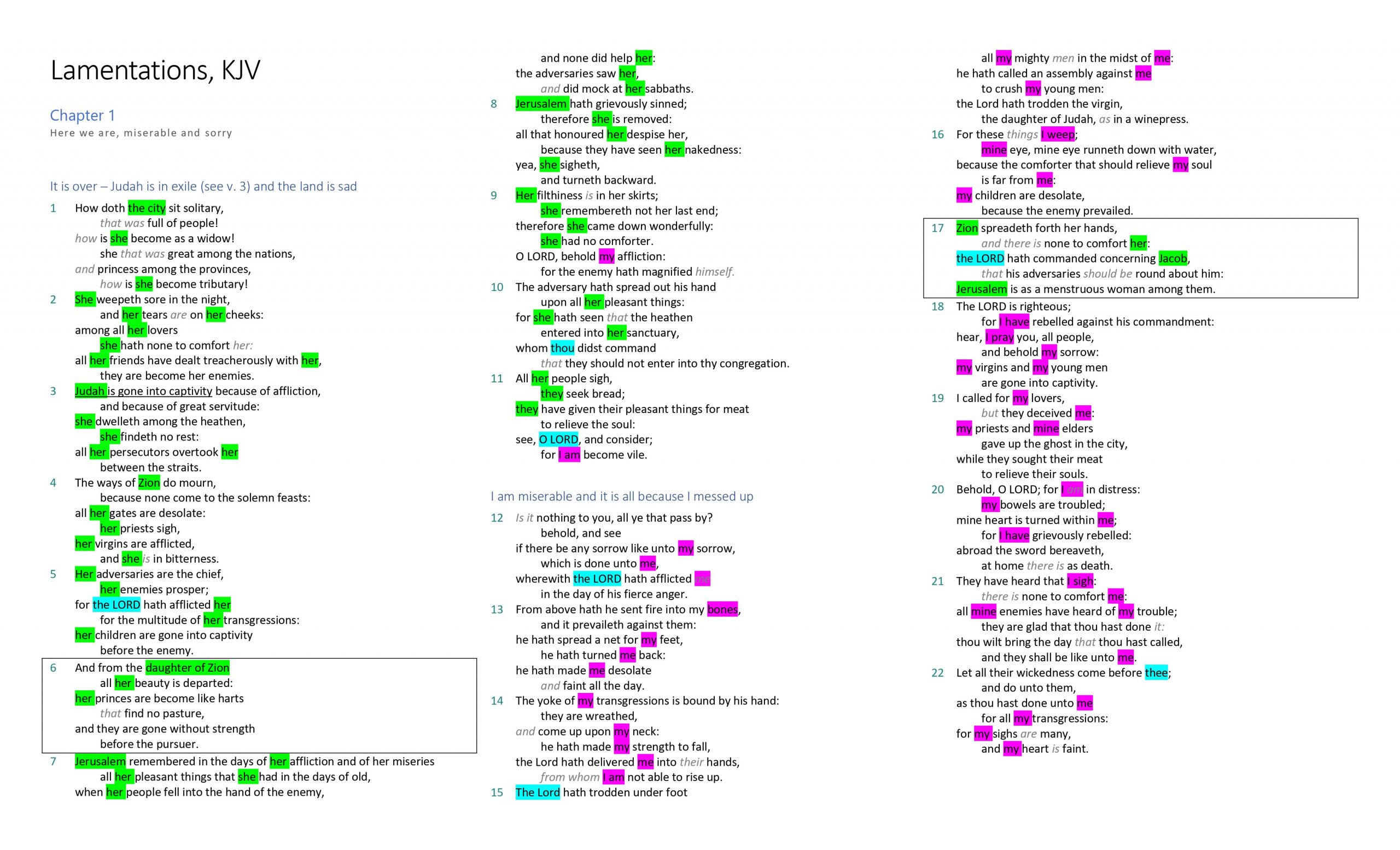In short
“Overachiever!” That’s the impression you get from whoever wrote this book. Five chapters, each a poem, and all of them are acrostics! And the middle is a triple-acrostic! But wait, gotcha! The last one is the right number of verses*, but it’s not an acrostic after all. OK, what? It’s like it is meant to toy with your mind.
Why it is important
It’s brilliant. The poems are, indeed, lamentations – poems that say, “Our lives have been ruined,” or “The society has been ruined,” basically. But the arrangement and style of the poems also have a point to make, too.
Main characters
- Judah/Jerusalem/Zion – the land in judgment. It is sometimes referred to as “we” or “us”; sometimes “they” or “her”; and in one section (2:13-19) as “you” (or “thee” in KJV).
- Also in 2:11 and 2:13, it seems the author is speaking himself?
What is in this book
Five chapters that are separate poems on the same theme: Judah in exile. Chapter 1 verse 3 spells this out, while the end of chapter 4 says Judah’s time in exile is over. But what about chapter 5? I guess that puts it after the return from exile? Maybe?
I found that within each chapter, it’s never the same pronouns when referring to Judah; they are in sections. OK I know, I’m losing you. Detour!
So, in language, there are three “persons”:
- First person – when you say “I” or “me” or “my” or “us” or “we”
- Second person – when you say “you” (or “thee” or “thou” in old English)
- Third person – when you say “he” or “she” or “him” or “they,” etc.
For example, in chapter 1 of Lamentations – and the pictures I attached will really show this – the first 11 verses are speaking of “the city” in the third person (“her”), and then the second half of the chapter switches to first person (“me” and “I”) but is still talking about Judah.

All of the chapters seem to go in sections like this, though only chapter 1 is so cleanly divided. What’s really cool is that the middle verse of each half of chapter 1 (boxed in the picture) speaks of Zion (also a mountain), so it’s like the two halves “peak” in their middles. Like, who goes to all of this trouble to write a lament?
Chapter 5 is striking in its disorder. It’s not an acrostic like the other chapters. Verse 18 seems entirely out of place considering that it is in the third person all by itself out there. Commentators have often thought that this is meant to represent the disorder of Judah, perhaps after returning from exile, and that does come through in the books (and characters) of Ezra and Nehemiah.
Other things I noticed:
- Each verse in chapters 1-2 consist of three couplets (indented pairs of lines)
- The verses in chapter 3 are single couplets but arranged in threes (each verse of the set of three starts with the same Hebrew letter)
- Verses in chapter 4 are two couplets each
- And chapter 5 has only single couplets
- Chapter 3, to me, is the only other chapter – other than chapter 1 – that is uber-structured. It’s not straight in half, but it seems to be in 3 sections of 6 triplets, with a single triplet (like a musical bridge) in the middle and a final section of 3 triplets.
Theology and doctrine
The phrase everyone remembers from this book is Lamentations 3:22-23, “The steadfast love of the LORD never ceases; his mercies never come to an end; they are new every morning; great is your faithfulness.”
It is roughly in the center of the book and is tremendously optimistic while the rest of the book is decidedly not. (It’s called Lamentations!) While there is nothing wrong with, say, making a song out of this, it is good to remember the context of it.
Footnotes
* But there are no verse numbers in the original Hebrew! Yes, yes, I know. Chapter 5 has 22, um, stanzas (?) of poetic couplets. Open a paper Bible and you’ll see the verses are very uniform in length. Hebrew poetry is not usually so consistent like this. It seems quite clear that the author is REALLY bending over backward to show chapter 5 as a non-acrostic 22-line poem.
Here is the entire book of Lamentations in KJV with my highlighting of first/second/third person and my own headings in blue and chapter notes in gray.

No responses yet